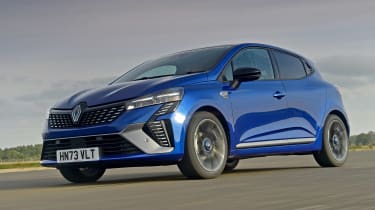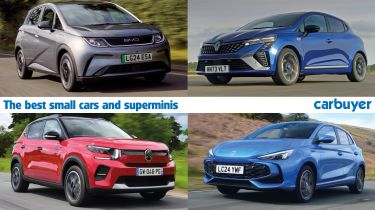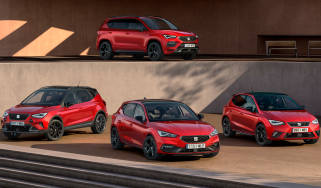Renault Clio review - E-Tech hybrid takes on EV rivals


Our dense cities and tight, twisty roads make small cars and superminis a popular choice in the UK. Many people don’t need something the size of an SUV, but often we want a little more practicality than a city car can provide, so superminis offer an ideal middle ground.
 Top 10 best cheap cars to insure
Top 10 best cheap cars to insure
As technology has progressed, superminis are far more capable than they once were. The latest models are just as happy to pootle around town as they are cruising on long stretches of motorway. Plenty of household names – such as the Vauxhall Corsa, Renault Clio and Volkswagen Polo – are still on the market today and are better than ever, while newcomers from less established brands have arrived to provide a fresh take on the supermini genre.
Petrol models still make up the bulk of supermini sales, but there are now several hybrid and fully electric alternatives that are equally good, if not better in some cases. Small EVs have also dramatically reduced in price, potentially making them just as affordable as a petrol supermini once you’ve factored in lower running costs.
For something a bit larger than the cars on this list, take a look at the best hatchbacks on sale, or why not read about the best small electric cars if you’re ready to leave combustion power behind.
The latest Renault Clio offers style as well as substance with its chic exterior design and practical, tech-filled interior. Soft touch materials and a large portrait-style touchscreen add to the Clio’s appeal, while a 391-litre boot can match several offerings from the class above. Families and first-time drivers will be happy to hear that the Clio has a five-star Euro NCAP safety rating and a five-year warranty should make ownership a breeze.
The 1.2-litre petrol engine is the obvious choice for most buyers, offering enough performance and pep for the average supermini customers. However, for those after really low running costs, the E-Tech Hybrid uses a small battery pack and a gearbox with F1-derived technology to increase its fuel efficiency to around 65mpg.
|
Pros |
Cons |
|
|
The winner in our Best Small Car category at the Carbuyer Best Car Awards 2023, the Skoda Fabia mixes value, practicality, and comfort. The Fabia is larger than ever, with a 380-litre boot that’s big enough to compete with larger hatchbacks like the Volkswagen Golf, while outstripping its rivals.
A big attraction for buyers is the amount of kit that’s available, including a heated steering wheel and windscreen, wireless smartphone charging and dual-zone climate control. These are features you wouldn’t necessarily expect in a budget small car, even stretching to a panoramic glass roof. Buyers can choose from a small selection of petrol engines – we’d skip the underpowered entry-level model and go for the mid-spec 1.0-litre TSI as this offers a solid blend of performance and fuel economy.
|
Pros |
Cons |
|
|
While its predecessor was a very underwhelming car, the latest MG3 is an incredibly impressive hybrid hatchback. Despite its bargain price, the hybrid setup comes on all MG3 models and provides a hot hatch-rivalling 192bhp, feels good to drive and delivers great fuel economy.
The MG3 is available in just two trims: SE and Trophy. You get a lot of equipment as standard, including a 10.25-inch infotainment system with sat nav, adaptive cruise control, lane keep assist and rear parking sensors. We think most buyers would be happy with that, but Trophy brings a heated steering wheel and front seats, 360-degree parking camera, LED headlights and blind spot monitoring tech. It’s quite impressive just how much you get for the money with the MG3, and that’s why it’s one of our favourite small cars.
|
Pros |
Cons |
|
|
The BYD Dolphin won our coveted Car of the Year title for 2024 because it’s a very well-priced EV and changed the rulebook when it launched. BYD may not yet be a household name in the UK, but a car like the Dolphin is just what it needs to make itself known, and should be on your shortlist if you’re looking for your first electric car.
The Dolphin comes with a lot of tech as standard, including a 12.8-inch rotating touchscreen, electronically-adjustable faux leather seats, and a 360-degree parking camera, and despite its low price for an EV, interior quality is good. Despite originally launching in just higher-spec Comfort and Design trims that boast a punchy 201bhp, even more affordable Active and Boost models were added later with 94bhp and 174bhp, respectively. While the Active model’s figure doesn’t sound like a lot, it will be enough for most urban buyers, and it still feels well equipped.
|
Pros |
Cons |
|
|
The Citroen e-C3 also makes it onto this list because it’s another affordable EV which has the potential to truly democratise the electric-car market and help buyers with modest budgets make the switch. This generation of C3 (and therefore the e-C3) has a more rugged higher-riding SUV-inspired look than the previous model, and it’s also quite spacious inside for rear passengers.
Citroen’s focus has always been more on comfort rather than driveability, and the e-C3 is no exception – we were impressed with how supple it was to ride in when we tested it, so it should make light work of the UK’s pothole-ridden roads. If you’re not keen on the idea of an electric car or don’t think you can fit one around your lifestyle, then the C3 is also offered with a 1.2-litre petrol engine or as a hybrid for better fuel economy.
|
Pros |
Cons |
|
|
If you’re after something more premium than the standard run-of-the-mill superminis, the Volkswagen Polo has long been a solid choice. The latest model is larger than before, coming close in size to the Volkswagen Golf and making it a viable option for small families. A facelift for 2021 brought much of the Mk8 Golf’s technology to the Polo too, with all cars now getting digital dials and an eight-inch touchscreen as standard.
The Polo range consists of three distinct trim levels, with the mid-spec Style model equipped with the 94bhp 1.0-litre TSI engine being our ideal specification. The Polo offers an incredibly refined driving experience for such a small car and can even be quite fun to drive – especially in sporty Polo GTI guise. The real thing that holds it back, however, is the cheaper and mechanically similar Skoda Fabia, which we feel offers greater value for money.
|
Pros |
Cons |
|
|
Peugeot’s latest models have helped the company turn the corner from an era in which its cars felt cheap and a bit dull, and the 208 is definitely one of them. The styling is instantly eye-catching, with LED fangs that are like nothing else in the class, while the influence of the classic Peugeot 205 is clear from some angles. It sits on a completely new platform, which has enabled the introduction of an electric Peugeot e-208 model with up to 248 miles of range.
The EV is expensive, starting from over £30,000. In fact, all models are a bit more expensive compared to rivals, and none are particularly fun to drive. We do like the hi-tech interior, though (even if the i-Cockpit seating position may turn off some buyers), while the petrol and diesel engines are tried-and-tested, offering strong performance and economy.
|
Pros |
Cons |
|
|
The latest Honda Jazz hybrid earns its place on this list first and foremost for its uncanny ability to swallow people and their luggage. It has an appetite for both that belies its small stature, thanks to a tall, upright design that makes it feel like a small MPV to drive. Clever styling that takes cues from the Honda Civic hatchback means the Jazz looks far from boxy or utilitarian, and the range-topping Crosstar EX trim adds an SUV aesthetic sure to broaden its appeal.
Step inside and you’ll find a Tardis-like interior with rear head and legroom to rival much bigger cars. You’ll also get the Jazz’s trademark ‘Magic Seats’ that fold flat to the floor or swing up cinema-style to turn the rear footwells into ideal storage for those awkwardly tall pot plants. The Jazz also features a reasonably sized 304-litre boot, but it’s not all about the storage. This small car is easy to drive around town, with light steering and a decent if unexceptional ride. The e:HEV powertrain is impressive, with a 1.5-litre petrol engine and twin electric motors with one driving the front wheels and the other converting energy for storage in the battery for use in EV mode. Drive it carefully, and the Jazz easily beats petrol and diesel rivals achieving over 60mpg. And of course, there’s the legendary Honda reliability.
|
Pros |
Cons |
|
|
The Vauxhall Corsa is one of the most popular cars on sale in the UK, driven by everyone from driving instructors to police officers to your average car buyer. The Corsa range extends out from an entry-level, petrol-powered SE Edition model to the range-topping Ultimate trim. There’s even an all-electric option, the Corsa Electric, with a range of up to 222 miles and access to 100kW rapid charging.
Boot space measures 309 litres, so while it isn’t class-leading, the Corsa remains competitive in this regard. All Corsa models come as standard with a 10-inch central touchscreen with Apple CarPlay and Android Auto. This is thanks to an upgrade to Vauxhall’s dual-screen Pure Panel setup when the Corsa was facelifted at the end of 2023.
|
Pros |
Cons |
|
|
It may not be the cheapest of the cars featured on this list, but the Yaris does make up for it with its low running costs thanks to Toyota’s tried and tested hybrid technology. The Japanese brand claims the Yaris could run on electricity for up to 80% of the time when driving around town, with the car getting official fuel economy figures of up to 68.8mpg, which we managed to closely match when we tested it.
We also think it’s quite a good-looking, stylish little supermini helped in part by the racey image of the GR Yaris hot hatch, though in reality the two cars are similar in name and a handful of styling cues only. The standard Yaris is well equipped, too, getting 16-inch alloy wheels, a seven-inch infotainment screen with Apple CarPlay and Android Auto, a rear-view camera, air con and automatic lights and wipers on entry-level Icon. There are three trim levels above this, adding further modcons and – in the case of the GR Sport – sportier styling inspired by the aforementioned GR Yaris hot hatch. A facelifted model with slightly more power and more tech was announced in late 2023, before arriving in showrooms in early 2024.
|
Pros |
Cons |
|
|
For something even smaller, check out our list of the top 10 best city cars...



